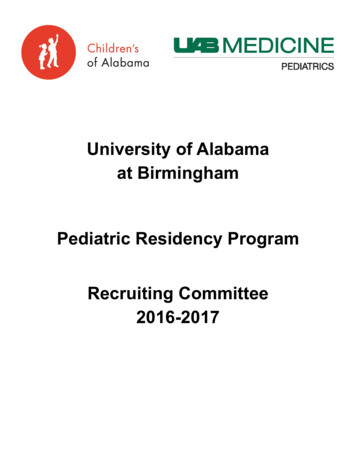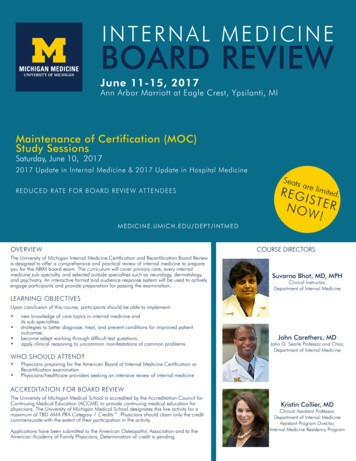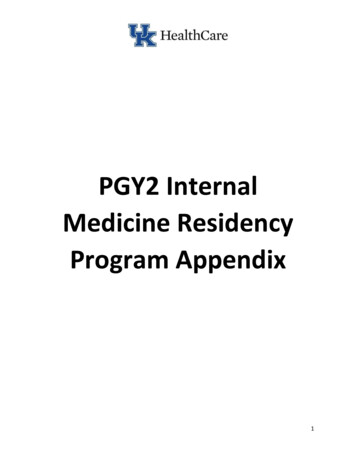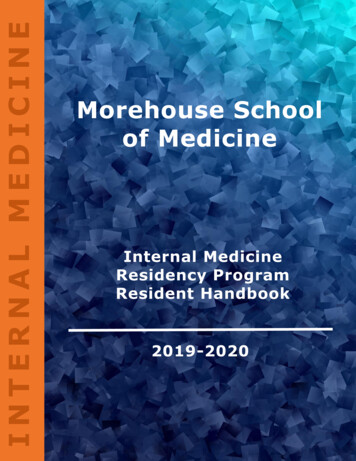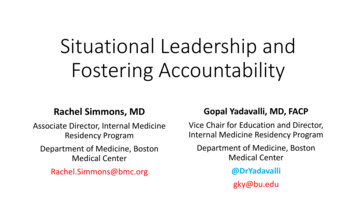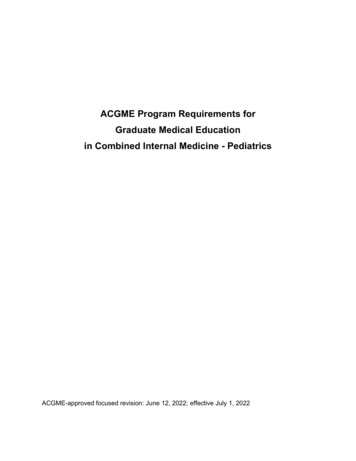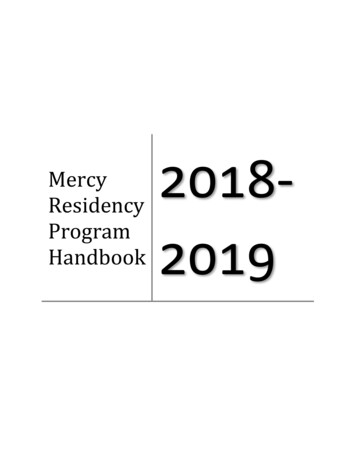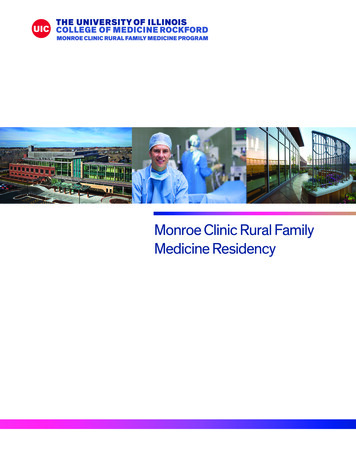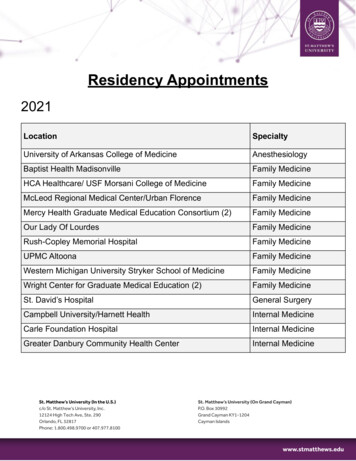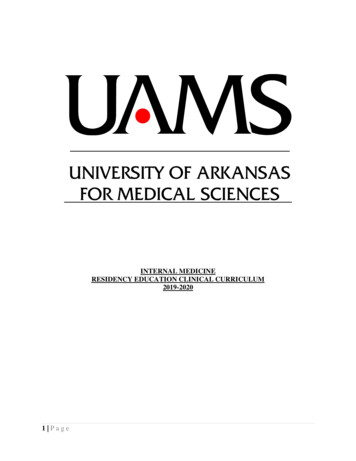
Transcription
INTERNAL MEDICINERESIDENCY EDUCATION CLINICAL CURRICULUM2019-20201 Page
TABLE OF CONTENTSPageINTRODUCTIONPurpose of residency trainingOverview of Rotation Goals and ObjectivesEvaluationsEducational ResourcesROTATION OBJECTIVESAbernathy Infectious Diseases Team (UAMS Team 6)Allergy and ImmunologyCardiology/CCU UAMS Team 18Cardiology/CCU VA Team 7Cardiology ConsultDermatologyElectrophysiology ConsultEmergency MedicineEndocrinologyGastroenterologyGeneral Medicine Ambulatory (Continuity Clinic) UAMSGeneral Medicine Ambulatory (Continuity Clinic) VAGeneral Medicine ConsultGeneral Medicine Ward UAMS Teams 3A and 3BGeneral Medicine Ward VA Teams 1-3GeriatricsHematology-Oncology UAMS Team 2A &2BHematology-Oncology Clinic UAMSHematology-Oncology Elective VAInfectious Diseases ConsultMICU UAMS, Acute Care Resident (ACR), Unit Night Float UAMSMICU VA and Unit Night Float VANephrologyNeurology ElectiveNeurology Ward UAMSPalliative CarePulmonaryResearchRheumatologyWard Night Float UAMSWard Night Float VA360-MULTI-RATER EVALUATIONPGY2/3 EVALUATION OF PGY1PGY1 EVALUATION OF PGY2/3AMBULATORY DIDACTIC CURRICULUMAPPENDIX: REPORTING MILESTONES2 8525456585963636466676970
INTRODUCTIONPurpose of Residency TrainingDuring residency training you will acquire the knowledge and skills necessary for thecomprehensive practice of internal medicine and the tools necessary for lifelong learning. Whatyou take away from your experiences during residency will provide the foundation for careers ingeneral internal medicine and in the internal medicine subspecialties. This document covers theclinical curriculum, (i.e. the goals and objectives of each clinical rotation), but does not includethe program’s didactic curriculum.Overview of Rotation ObjectivesFor each rotation, your performance is measured by how effectively you achieve theobjectives found in the body of this document. Please realize the specific goals and objectives donot include all that you are expected to learn or will learn during a rotation.For faculty evaluations of resident performance, there are 2 types of objectives, those thatare content-based and those that are process-based. Content-based objectives are specific toeach rotation and generally reflect the core competencies of medical knowledge and patient care.Process-based objectives generally reflect the core competencies of systems-based practice,practice-based learning and improvement, professionalism, and interpersonal and communicationskills.EvaluationsWe use multiple sources to evaluate you during residency. These sources include:1. End-of-rotation evaluations by attendings based upon the rotation goals andobjectives2. Direct observations by attendings, using a mini-clinical examination (CEX) tool3. Multisource (360) evaluations by interprofessional team members (nurses, socialworkers, case managers)4. Peer evaluations (PGY2/3 evaluations of PGY1 and PGY1 evaluations of PGY2/3)5. Self-evaluations6. Patient evaluations7. In-Training Exam results (for medical knowledge only)For each rotation, your attendings will grade your performance based upon the degreewith which they trust you to attain/perform each objective at the conclusion of therotation. In this context, each objective is an Entrustable Professional Activity (EPA).The evaluation scale based on level of entrustment is:0. You are unable to achieve the objective even with supervision1. You can achieve the objective with direct supervision (supervising physician trustsyou when he/she is physically present)2. You can achieve the objective with indirect supervision (supervising physician trustsyou when he/she is on-site or readily available by phone or electronic means and isavailable to provide direct supervision)3. You can achieve the objective without supervision (independently)3 Page
4. You can achieve the objective at the level of an expert (aspirational)The anticipated progression is for interns to move from level 1 entrustment to level 2during the PGY1 year and for upper level residents to move from level 2 to 3 during thePGY2/3 years, so that by the conclusion of training you will be able to perform allentrustable activities without supervision and therefore be ready to practice internalmedicine independently. We expect very few, if any, residents to attain level 4entrustment in any activity.All UAMS residency programs use New Innovations software for evaluations. TheProgram Director or his designee plots your individual progression as you move throughtraining based on all of your evaluations. The Department’s Clinical CompetencyCommittee (CCC) meets biannually to review your progress. Data based on theperformance of each resident are transmitted to the Accreditation Council for GraduateMedical Education (ACGME) biannually in the form of 22 Reporting Milestones(Appendix 1), which reflect your evaluations, which, in turn, reflect the degree withwhich your attendings and other evaluators trust you to perform the activities (i.e. attainthe objectives) for every rotation.Educational Resources1. Numerous electronic resources available from the UAMS library both on and offcampus at spx. This includesonline access journals, books (including Harrison’s Principles of Internal Medicine),and UpToDate.2. MKSAP3. Other recommended resources:a. The Stanford 25- an initiative to revive the culture of bedside medicine athttp://stanfordmedicine25.stanford.edu/b. CDIM-APDIM Residents as Teachers Modules athttp://im.org/p/cm/ld/fid 401c. Society of Hospital Medicine Consultative and Perioperative MedicineEssentials for Hospitalists at http://www.shmconsults.com/d. American College of Physicians High Value Care website, includingcurriculum and online cases at http://hvc.acponline.org/4. UAMS GME video on how to manage fatigue effectively:http://libvideo.uams.edu/Resident/Rock Star Resident.mp44 Page
ROTATION OBJECTIVESRotation: Abernathy Infectious Diseases (UAMS Team 6)PurposeThe purpose of this inpatient ward rotation is to provide the resident experience in thediagnosis and management of a broad spectrum of infectious diseases that necessitateadmission to the hospital from the Emergency Department, the Infectious Diseases Clinic, oroutside hospital transfer. Common diagnoses include AIDS and its complications, infectiveendocarditis, osteomyelitis, pneumonia, tick-borne diseases, and central nervous systeminfections.Content Objectives1) Evaluate a patient with unexplained fever2) Identify the appropriate prophylactic medications for the AIDS patient depending onCD4 count3) Diagnose opportunistic infection in a patient with AIDS4) Identify the common antiretroviral drugs used to treat HIV5) Evaluate and treat a patient with pneumonia6) Evaluate and treat a patient with infective endocarditis7) Evaluate and treat a patient with osteomyelitis8) Evaluate and treat a patient with meningitis9) Evaluate and treat a patient skin and soft tissue infection10) Recognize and treat tick-borne infections seen in ArkansasProcess Objectives1) Work effectively within an interprofessional team2) Recognize system error and advocate for system improvement3) Identify forces that impact the cost of health care, and advocate for, and practice costeffective care4) Transition patients effectively within and across health care delivery systems5) Learn and improve via feedback6) Have professional and respectful interactions with patients, caregivers, and members ofthe interprofessional team7) Accept responsibility and follow through on tasks8) Exhibit integrity and ethical behavior in professional conduct9) Communicate effectively with patients and caregivers10) Appropriately utilize and complete health records11) Stabilize patients with urgent or emergent medical conditions and transfer to a higherlevel of care when necessary12) Modify the differential diagnosis and care plan based on clinical course and data asappropriateMapping to Reporting MilestonesObjective5 PageReporting Milestone(s)
Content-based1) Evaluate a patient with unexplained fever2) Identify the appropriate prophylactic medicationsfor the AIDS patient depending on CD4 count3) Diagnose opportunistic infections in patients withAIDS4) Identify the common antiretroviral drugs used totreat HIV5) Evaluate and treat a patient with pneumonia6) Evaluate and treat a patient with infectiveendocarditis7) Evaluate and treat a patient with osteomyelitis8) Evaluate and treat a patient with meningitis9) Evaluate and treat a patient skin and soft tissueinfection10) Recognize and treat tick-borne infections seen inArkansasProcess-based1(PC1), 6(MK1)2(PC2), 6(MK1)1(PC1), 5(PC5), 7(MK2)6(MK1)1(PC1), 2(PC2), 7(MK2)1(PC1), 2(PC2), 7(MK2)1(PC1), 2(PC2), 7(MK2)1(PC1), 2(PC2), 7(MK2)1(PC1), 2(PC2), 6(MK1)2(PC2), 6(MK1)1) Work effectively within an interprofessional team2) Recognize system error and advocate for systemimprovement3) Identify forces that impact the cost of health care,and advocate for, and practice cost-effective care4) Transition patients effectively within and acrosshealth care delivery systems5) Learn and improve via feedback8(SBP1)9(SBP2)6) Have professional and respectful interactions withpatients, caregivers, and members of theinterprofessional team7) Accept responsibility and follow through on tasks8) Exhibit integrity and ethical behavior inprofessional conduct9) Communicate effectively with patients andcaregivers10) Appropriately utilize and complete health records11) Stabilize patients with urgent or emergent medicalconditions and transfer to a higher level of carewhen necessary12) Modify the differential diagnosis and care planbased on clinical course and data as appropriate16(PROF1)6 ICS1)22(ICS3)2(PC2), 3(PC3), 11(SBP4)15(PBLI4)
Rotation: Allergy and ImmunologyPurposeThe general internist commonly encounters patients with signs and symptoms caused byallergic and immunologic disorders. The purpose of this rotation is to provide the residentwith an understanding of basic allergic and immunologic disease processes and skillsnecessary to evaluate and treat patients with these disorders.Content Objectives1) Assess asthma severity and control2) Define the concepts/medications involved in the treatment of asthma3) Recognize the differences between asthma and chronic obstructive pulmonary disease4) Appreciate the complexities of the patient with rhinitis5) Differentiate between true, IgE-mediated food allergy and other forms of adverse foodreactions6) Manage the food allergic patient7) Diagnose urticaria and angioedema, appreciate the various causes, and develop anunderstanding of basic treatment algorithms8) Identify the role of markers of mast cell activation in elucidating a cause for urticaria,angioedema, and anaphylaxis9) Recognize the signs and symptoms of anaphylaxis and understand the importance ofprompt treatment with epinephrine10) Differentiate between types of drug hypersensitivity reactions11) Appreciate the limitations of drug allergy testing12) Explain the concept of drug desensitization and its utility13) Diagnose and manage atopic dermatitis14) Recognize the roles of T-cells, B-cells, neutrophils, the complement system, and theinnate immune system in the immune response15) Apply the basic laboratory modalities used to diagnose immune deficienciesProcess Objectives1) Learn and improve via feedback2) Learn and improve at point of care3) Have professional and respectful interactions with patients, caregivers, and members ofthe interprofessional team4) Accept responsibility and follow through on tasks5) Communicate effectively with patients and caregivers6) Communicate effectively in interprofessional teamsMapping to Reporting MilestonesObjectiveContent-based1) Assess asthma severity and control2) Define the concepts/medications involved in thetreatment of asthma7 PageReporting Milestone(s)1(PC1)2(PC2), 6(MK1)
3) Recognize the differences between asthma andchronic obstructive pulmonary disease4) Appreciate the complexities of the patient withrhinitis5) Differentiate between true, IgE-mediated foodallergy and other forms of adverse food reactions6) Manage the food allergic patient7) Diagnose urticaria and angioedema, appreciatethe various causes, and develop an understandingof basic treatment algorithms8) Identify the role of markers of mast cell activationin elucidating a cause for urticaria, angioedema,and anaphylaxis9) Recognize the signs and symptoms of anaphylaxisand understand the importance of prompttreatment with epinephrine10) Differentiate between types of drughypersensitivity reactions11) Appreciate the limitations of drug allergy testing12) Explain the concept of drug desensitization andits utility13) Diagnose and manage atopic dermatitis14) Recognize the roles of T-cells, B-cells,neutrophils, the complement system, and theinnate immune system in the immune response15) Apply the basic laboratory modalities used todiagnose immune deficienciesProcess-based1) Learn and improve via feedback2) Learn and improve at point of care3) Have professional and respectful interactions withpatients, caregivers, and members of theinterprofessional team4) Accept responsibility and follow through on tasks5) Communicate effectively with patients andcaregivers6) Communicate effectively in interprofessionalteams1(PC1), 6(MK1), 7(MK2)1(PC1), 6(MK1)1(PC1), 6(MK1)2(PC2)1(PC1), 6(MK1)6(MK1)1(PC1), 2(PC2)1(PC1), 6(MK1)6(MK1)6(MK1)1(PC1), OF2)20(ICS1)21(ICS2)Rotations: Cardiology/CCU UAMS Team 1 Cardiology and Cardiology/CCU VA Team 7Cardiology/CCUPurpose8 Page
The purpose of these inpatient rotations is to provide the resident with experience in thediagnosis and management of a broad range of cardiovascular diseases encountered in theinpatient setting. UAMS and the VA constitute 2 separate rotations for Cardiology/CCU.Content Objectives1) Demonstrate basic ECG reading skills and apply them in management decisions2) Risk stratify patients with chest pain and manage their work-up and treatment3) Identify the basics of key cardiac testing modalities and use these for the management ofpatients4) Manage patients with STEMI, non-STEMI, and unstable angina according torecommended guidelines5) Manage patients with congestive heart failure according to recommended guidelines6) Manage patients with atrial fibrillation according to recommended guidelines7) Know the indications and contraindications for anti-thrombotic therapy and apply thesein patient management8) Know the current recommendations for the prevention of CV disease and utilize these inthe care of patients9) Interpret basic rhythm abnormalities and manage patients with these conditionsProcess Objectives1) Come to rounds prepared with knowledge of your patients, especially the events since theprevious day’s rounds2) Provide an organized, accurate oral summary of your patients3) Utilize information technology to find and review any assigned topics or literaturerelevant to your patients4) Prepare patient encounter information for each patient daily5) Write notes daily on patients with a focus on creating a concise and accurate summary ofthe appropriate material6) Participate in daily rounds to include presentation of a diagnostic and treatment plan forall patients under your care7) Demonstrate concern for each of your patients, work to understand their goals fortreatment, and commit yourself to work for their best-interest8) View your work in the context of a multidisciplinary healthcare team and strive to keepothers appropriately informed9) Exercise concerned stewardship in the utilization of resources in the care of patients10) Organize discharges and transfers to insure continuity of care11) Consider ways to improve the delivery of healthcareMapping to Reporting MilestonesObjectiveContent-based1) Demonstrate basic ECG reading skills and applythem in management decisions2) Risk stratify patients with chest pain and managetheir work-up and treatment9 PageReporting Milestone(s)2(PC2), 7(MK2)2(PC2), 7(MK2)
3) Identify the basics of key cardiac testingmodalities and use these for the management ofpatients4) Manage patients with STEMI, non-STEMI, andunstable angina according to recommendedguidelines5) Manage patients with congestive heart failureaccording to recommended guidelines6) Manage patients with atrial fibrillation accordingto recommended guidelines7) Know the indications and contraindications foranti-thrombotic therapy and apply these in patientmanagement8) Know the current recommendations for theprevention of CV disease and utilize these in thecare of patients9) Interpret basic rhythm abnormalities and managepatients with these conditionsProcess-based1) Come to rounds prepared with knowledge of yourpatients, especially the events since the previousday’s rounds2) Provide an organized, accurate oral summary ofyour patients3) Utilize information technology to find and reviewany assigned topics or literature relevant to yourpatients4) Prepare patient encounter information for eachpatient daily5) Write notes daily on patients with a focus oncreating a concise and accurate summary of theappropriate material6) Participate in daily rounds to include presentationof a diagnostic and treatment plan for all patientsunder your care7) Demonstrate concern for each of your patients,work to understand their goals for treatment, andcommit yourself to work for their best-interest8) View your work in the context of amultidisciplinary healthcare team and strive tokeep others appropriately informed9) Exercise concerned stewardship in the utilizationof resources in the care of patients10) Organize discharges and transfers to insurecontinuity of care10 P a g e7(MK2)2(PC2), 6(MK1)2(PC2), 6(MK1)2(PC2), 6(MK1)2(PC2), 6(MK1), 18(PROF3)2(PC2), 6(MK1), 18(PROF3)2(PC2), 7(MK2)1(PC1), 17(PROF2)21(ICS2)12 (PBLI1), 13 (PBLI2),15(PBL4), 17(PROF2)17 (PROF2)22(ICS3)16(PROF1), 21(ICS2)18(PROF3), 19(PROF4),20(ICS1)8(SBP1), 21(ICS2)10(SBP3)11(SBP4)
11) Consider ways to improve the delivery ofhealthcare9(SBP2), 12(PBLI1),13(PBLI2)Rotation: Cardiology ConsultPurposeThe purpose of this consult rotation is to provide the resident with experience in thediagnosis and management of a broad range of cardiovascular diseases encountered in theinpatient setting.Content Objectives1) Demonstrate basic ECG reading skills and apply them in management decisions2) Risk stratify patients with chest pain and manage their work-up and treatment3) Identify the basics of key cardiac testing modalities and use these for the management ofpatients4) Manage patients with STEMI, non-STEMI, and unstable angina according torecommended guidelines5) Manage patients with congestive heart failure according to recommended guidelines6) Manage patients with atrial fibrillation according to recommended guidelines7) Know the indications and contraindications for anti-thrombotic therapy and apply thesein patient management8) Know the current recommendations for the prevention of CV disease and utilize these inthe care of patients9) Interpret basic rhythm abnormalities and manage patients with these conditions10) Risk stratify patients pre-operatively and identify high risk features/diagnoses for whichelective procedures should be postponedProcess Objectives1) Come to rounds prepared with knowledge of your patients, especially the events since theprevious day’s rounds2) Provide an organized, accurate oral summary of your patients3) Utilize information technology to find and review any assigned topics or literaturerelevant to your patients4) Prepare patient encounter information for each patient daily5) Write notes daily on patients with a focus on creating a concise and accurate summary ofthe appropriate material6) Participate in daily rounds to include presentation of a diagnostic and treatment plan forall patients under your care7) Demonstrate concern for each of your patients, work to understand their goals fortreatment, and commit yourself to work for their best-interest8) View your work in the context of a multidisciplinary healthcare team and strive to keepothers appropriately informed9) Exercise concerned stewardship in the utilization of resources in the care of patients10) Identify the role of a consultant, focus on the key questions or requests being made of theconsult team and ensure prompt responsiveness11 P a g e
11) Consider ways to improve the delivery of healthcareMapping to Reporting MilestonesObjectiveContent-based1) Demonstrate basic ECG reading skills and applythem in management decisions2) Risk stratify patients with chest pain and managetheir appropriate work-up and treatment3) Identify the basics of key cardiac testingmodalities and use these for the management ofpatients4) Manage patients with STEMI, non-STEMI, andunstable angina according to recommendedguidelines5) Manage patients with congestive heart failureaccording to recommended guidelines6) Manage patients with atrial fibrillation accordingto recommended guidelines7) Know the indications and contraindications foranti-thrombotic therapy and apply these in patientmanagement8) Know the current recommendations for theprevention of CV disease and utilize these in thecare of patients9) Interpret basic rhythm abnormalities and managepatients with these conditions10) Risk stratify patients pre-operatively and identifyhigh risk features/diagnoses for which electiveprocedures should be postponedProcess-based1) Come to rounds prepared with knowledge of yourpatients, especially the events since the previousday’s rounds2) Provide an organized, accurate oral summary ofyour patients3) Utilize information technology to find and reviewany assigned topics or literature relevant to yourpatients4) Prepare patient encounter information for eachpatient daily12 P a g eReporting Milestone(s)2(PC2), 7(MK2)2(PC2), 7(MK2)7(MK2)2(PC2), 6(MK1)2(PC2), 6(MK1)2(PC2), 6(MK1)2(PC2), 6(MK1), 18(PROF3)2(PC2), 6(MK1), 18(PROF3)2(PC2), 7(MK2)1(PC1), 6(MK1), 18(PROF3)1(PC1), 17(PROF2)21(ICS2)12 (PBLI1), 13 (PBLI2),15(PBL4), 17(PROF2)17 (PROF2)
5) Write notes daily on patients with a focus oncreating a concise and accurate summary of theappropriate material6) Participate in daily rounds to include presentationof a diagnostic and treatment plan for all patientsunder your care7) Demonstrate concern for each of your patients,work to understand their goals for treatment, andcommit yourself to work for their best-interest8) View your work in the context of amultidisciplinary healthcare team and strive tokeep others appropriately informed9) Exercise concerned stewardship in the utilizationof resources in the care of patients10) Identify the role of a consultant, focus on the keyquestions or requests being made of the consultteam and ensure prompt responsiveness11) Consider ways to improve the delivery ofhealthcare22(ICS3)16(PROF1), 21(ICS2)18(PROF3), 19(PROF4),20(ICS1)8(SBP1), 21(ICS2)10(SBP3)5(PC5), 8(SBP1),16(PROF1), 21(ICS2)9(SBP2), 12(PBLI1),13(PBLI2)Rotation: DermatologyPurposeBecause of the frequency and potential importance of skin disorders, internists should beable to recognize and initiate management of many common dermatologic conditions.The purpose of this elective is to familiarize the resident with the principles ofdermatologic diagnosis and treatment. Residents will see common and some rare skindisorders, and have an opportunity to participate in learning skin biopsy techniques.Content Objectives1) Perform a systematic full skin examination and utilize terms of skin anatomy2) Describe skin lesions using correct standard terminology3) Educate patients on appropriate sun protection techniques4) Educate patients on signs and symptoms of skin cancer5) Recognize characteristic signs of the most common pre-malignant and malignantneoplasms including actinic keratosis, basal cell carcinomas, squamous cell carcinomasand melanomas6) Recognize common benign skin lesions including seborrheic keratosis, angiomas,lentigines and intradermal nevi7) Recognize common skin conditions including psoriasis, seborrheic dermatitis, tineacorporis and atopic dermatitis8) Identify first line treatments for these conditions including topical steroids andantifungals9) Perform basic dermatologic procedures including cryotherapy, shave biopsies and punchbiopsies13 P a g e
10) Obtain skin scraping for KOH and/or mineral oil prep and identify dermatophytes andscabies utilizing microscopyProcess Objectives1) Learn and improve via feedback2) Utilize information technology to find and review any assigned topics or literaturerelevant to your patients3) Have professional and respectful interactions with patients, caregivers, and members ofthe interprofessional team4) Accept responsibility and follow through on tasks5) Communicate effectively with patients and caregivers6) Communicate effectively in interprofessional teamsMapping to Reporting MilestonesObjectiveContent-based1) Perform a systematic full skin examination andutilize terms of skin anatomy2) Describe skin lesions using correct standardterminology3) Educate patients on appropriate sun protectiontechniques4) Educate patients on signs and symptoms of skincancer5) Recognize characteristic signs of the mostcommon pre-malignant and malignant neoplasmsincluding actinic keratosis, basal cell carcinomas,squamous cell carcinomas and melanomas6) Recognize common benign skin lesions includingseborrheic keratosis, angiomas, lentigines andintradermal nevi7) Recognize common skin conditions includingpsoriasis, seborrheic dermatitis, tinea corporis andatopic dermatitis8) Identify first line treatments for these conditionsincluding topical steroids and antifungals9) Perform basic dermatologic procedures includingcryotherapy, shave biopsies and punch biopsies10) Obtain skin scraping for KOH and/or mineral oilprep and identify dermatophytes and scabiesutilizing microscopyProcess-based1) Learn and improve via feedback14 P a g eReporting Milestone(s)1(PC1), 6(MK1)6(MK1), 21(ICS2)6(MK1), 18(PROF3), 20(ICS1)6(MK1), 18(PROF3), 20(ICS1)1(PC1), 6(MK1)1(PC1), 6(MK1)1(PC1), 6(MK1)2(PC2)4(PC4), 7(MK2)4(PC4), 7(MK2)14(PBLI3)
2) Utilize information technology to find and reviewany assigned topics or literature relevant to yourpatients3) Have professional and respectful interactions withpatients, caregivers, and members of theinterprofessional team4) Accept responsibility and follow through on tasks5) Communicate effectively with patients andcaregivers6) Communicate effectively in interprofessionalteams12(PBLI1), 13(PBLI2),15(PBL4), n: Electrophysiology (EP) ConsultPurposeThe purpose of this consult rotation is to provide the resident with experience in the diagnosisand management of a broad range of clinical electrophysiology diseases encountered in theinpatient setting. It is designed for those residents who seek a more in depth education in EP thanwhat is achievable on the cardiology consult rotation. In any given academic year, a resident canbe assigned to either the EP Consult service or the Cardiology Consult service, but not both.Content Objectives1) Demonstrate ECG reading skills and apply them in management decisions2) Diagnose and manage patients with SVT including atrial fibrillation, atrial flutter, andAVNRT3) Diagnose and manage patients with wide complex tachycardia4) Demonstrate the ability to diagnose and manage basic cardiac device problems5) Observe and assist in procedures such as elective DC cardioversion and tilt table testingProcess Objectives1) Come to rounds prepared with knowledge of your patients, especially the events since theprevious day’s rounds2) Provide an organized, accurate oral summary of your patients3) Utilize information technology to find and review any assigned topics or literature relevant toyour patients4) Prepare patient encounter information for each patient daily5) Write notes daily on patients with a focus on creating a concise and accurate summary of theappropriate material6) Participate in daily rounds to include presentation of a diagnostic and treatment plan for allpatients under your care7) Demonstrate concern for each of your patients, work to understand their goals for treatment,and commit yourself to work for their best-interest8) View your work in the context of a multidisciplinary healthcare team and strive to keep othersappropriately informed15 P a g e
9) Exercise concerned stewardship in the utilization of resources in the care of patients10) Identify the role of a consultant, focus on the key questions or requests being made of theconsult team and ensure prompt responsiveness11) Consider ways to improve the delivery of healthcareMapping to Reporting MilestonesObjectiveContent-based1) Demonstrate ECG reading skills and apply them inmanagement decisions2) Diagnose and manage patients with SVT includingatrial fibrillation, atrial flutter, and AVNRT3) Diagnose and manage patients with wide complextachycardia4) Demonstrate the ability to diagnose and manage basiccardiac device problems5) Observe and assist in procedures such as elective DCcardioversion and tilt table testingProcess-based1) Come to rounds prepared with knowledge of yourpatients, especially the events since the previousday’s rounds2) Provide an organized, accurate oral summary ofyour patients3) Utilize information technology to find and reviewany assigned topics or literature relevant to yourpatients4) Prepare patient encounter information for eachpatient daily5) Write notes daily on patients with a focus oncreating a concise and accurate summary of theappropriate material6) Participate in daily rounds to include presentationof a diagnostic and treatment plan for all patientsunder your care7) Demonstrate concern for each of your patients,work to understand their goals for treatment, an
general internal medicine and in the internal medicine subspecialties. This document covers the . online access journals, books (including Harrison's Principles of Internal Medicine), and UpToDate. 2. MKSAP 3. Other recommended resources: a. The Stanford 25- an initiative to revive the culture of bedside medicine at
